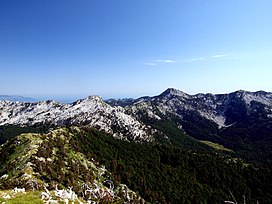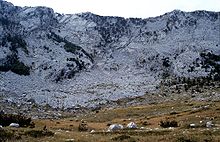
Back Орен Bulgarian Orjen BS Orjen (tumoy sa bukid) CEB Orjen Czech Orjen German Orjen Spanish اورجن Persian Orjen French Orjen Croatian Orjenas Lithuanian
This article needs additional citations for verification. (November 2023) |
| Orjen | |
|---|---|
| Орјен | |
 View of Orjen with peaks Veliki kabao (right) and Vučji zub (left) | |
| Highest point | |
| Elevation | 1,895 m (6,217 ft) |
| Coordinates | 42°34′08″N 18°32′56″E / 42.56889°N 18.54889°E |
| Geography | |
| Parent range | Dinaric Alps |
| Geology | |
| Age of rock | Cretaceous |
| Mountain type | Fold mountain |
| Type of rock | Glaciokarst |




Orjen (Serbian Cyrillic: Орјен, pronounced [ɔ̂rjɛn]) is a transboundary Dinaric Mediterranean limestone mountain range, located between southernmost Bosnia and Herzegovina and southwestern Montenegro.
Its highest peak is Veliki kabao, which stands at 1,895 m (6,217 ft). The Orjen Peak is the highest peak in the Sub-Adriatic Dinarides. The massif of Orjen lies east to south-east of Trebinje in Bosnia and Herzegovina and north-west of Risan in Bay of Kotor (Boka Kotorska). From the town of Risan, situated at the innermost protected part of the bay, a well-engineered road, at first metalled, with many hairpin bends climbs to about 1600 m, over to the interior. At the main summit of Orjen and the surrounding ridges and high plateaus the action of quaternary glaciation is evident. During the Ice Age, long valley glaciers receded from Orjen to the Bay of Kotor and surrounding poljes. Hollowing U-shaped valleys and cirques in their course. Glaciers also shaped jagged peaks and ridges. Glacial and karst type relief combine now in a unique coastal scenery. There are few places elsewhere in the Mediterranean which demonstrate similar phenomena.
The Natural and Culturo-Historical Region of Kotor is a UNESCO World Heritage site, comprising the territory between Orjen and Lovćen, including all the small towns in the bays of Risan and Kotor with their natural setting. With this privileged natural harbour the Bay of Kotor has been settled for millennia. Illyrians[citation needed] and Greeks[citation needed] colonised the coast from 400 BC and established today's ports Risan (Rhizon) and Kotor (Cattaro). Due to lack of potable water, the high mountain was never densely populated. Snow patches collected from deep pit holes were used even late in the 20th century to provide the few hamlets with water. Today, wells are used instead.
© MMXXIII Rich X Search. We shall prevail. All rights reserved. Rich X Search
